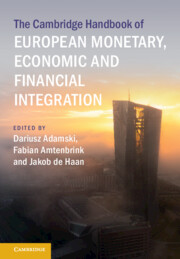Book contents
- The Cambridge Handbook of European Monetary, Economic and Financial Integration
- The Cambridge Handbook of European Monetary, Economic and Financial Integration
- Copyright page
- Contents
- Contributors
- Introduction
- Part I The Economic and Monetary Union
- Part II The Monetary Dimension
- Part III The Economic and Fiscal Dimensions
- 15 Reviving the Case for Policy Coordination in EMU
- 16 Ten Years of the European Semester
- 17 The EU Fiscal Rules
- 18 National Fiscal Policy in EMU
- 19 The Politics of Fiscal Integration in Eurozone Reforms and Next Generation EU
- 20 Adjustments in Economic Crises
- 21 Designing a Permanent EU-Wide Stabilization Facility
- 22 Enhancing Private and Public Risk Sharing
- Part IV Financial Integration
- Index
- References
18 - National Fiscal Policy in EMU
Insufficient Sustainability and Stabilization?
from Part III - The Economic and Fiscal Dimensions
Published online by Cambridge University Press: 28 September 2023
- The Cambridge Handbook of European Monetary, Economic and Financial Integration
- The Cambridge Handbook of European Monetary, Economic and Financial Integration
- Copyright page
- Contents
- Contributors
- Introduction
- Part I The Economic and Monetary Union
- Part II The Monetary Dimension
- Part III The Economic and Fiscal Dimensions
- 15 Reviving the Case for Policy Coordination in EMU
- 16 Ten Years of the European Semester
- 17 The EU Fiscal Rules
- 18 National Fiscal Policy in EMU
- 19 The Politics of Fiscal Integration in Eurozone Reforms and Next Generation EU
- 20 Adjustments in Economic Crises
- 21 Designing a Permanent EU-Wide Stabilization Facility
- 22 Enhancing Private and Public Risk Sharing
- Part IV Financial Integration
- Index
- References
Summary
Two main goals of the Stability and Growth Pact (SGP) are fiscal sustainability and fiscal policies’ contribution to economic stabilization. However, from the very beginning, several Member States of the European Economic Monetary Union (EMU) failed to stay within the SGP’s reference values, all too often leading to large fiscal imbalances, procyclical fiscal policies, and public debt overhangs. The SGP has therefore been revised several times to improve the enforceability and flexibility of the fiscal rules. In practice, however, these amendments made the European fiscal framework overly complex and incoherent, leaving national governments with too little incentive to pursue a prudent fiscal stance. To (better) promote fiscal sustainability in the EMU, the current weaknesses of the SGP need to be addressed. Several options have been suggested, mainly to decentralize the responsibility for fiscal discipline back to the national level or to reform the current framework. Notably, the latter option seems more likely to be implemented. Most proposals suggest a prominent role for an expenditure rule, augmented with a debt anchor. These proposals make perfect sense, but a discussion on the effectiveness and reform of the SGP shows that they will not remedy all current shortcomings of the fiscal rules.
- Type
- Chapter
- Information
- Publisher: Cambridge University PressPrint publication year: 2023
References
- 1
- Cited by

